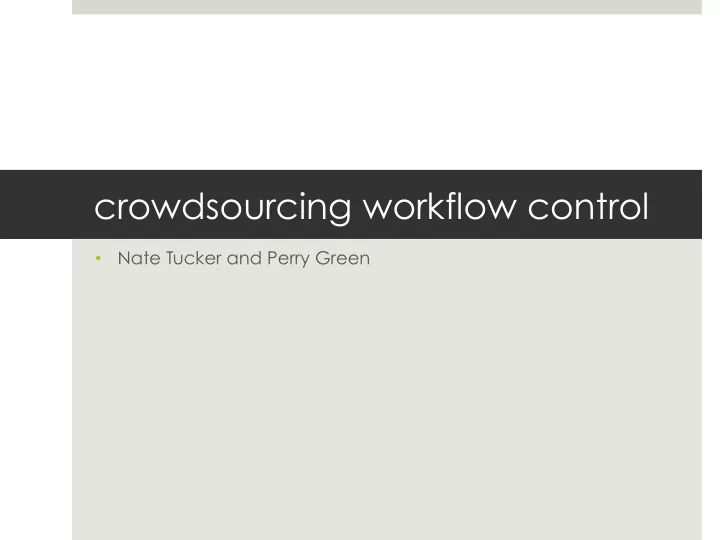

crowdsourcing workflow control • Nate Tucker and Perry Green
barriers to effective crowdsourcing ¤ Last time: ¤ Ensure proper incentives: ¤ Positive and negative ¤ Social and economic ¤ This time: ¤ How can we help people answer the question correctly? ¤ How can we aggregate lots of responses into a single answer? ¤ Sound familiar? It’s all about information aggregation.
dynamically switching between synergistic workflows for crowdsourcing ¤ Motivation: why would two workflows be better than one (even if, on average, one is known to yield more accurate results)? ¤ Workers have different skillsets ¤ Different errors in different workflows ¤ Examples?
how should we change the model? ¤ Before: Learn the best workflow. Use it. ¤ After: Dynamically choose workflows to maximize certainty of your answer.
decision-theoretic agent ¤ So far we have a model for accuracy, but not how to actually decide what task to use/when to return an answer. ¤ We need to: ¤ Given initial difficulty/error parameters, decide whether to make a new task, or return an answer ¤ If we made a new task and got new information, update our parameters and repeat
decision given parameters - POMDP ¤ Partially observable Markov decision process: ¤ Markov decision process: ¤ Given states, actions, transition probabilities, and rewards, find the best policy (action to take in each state) ¤ Partially observable: ¤ You don’t know what state you are in ¤ For our purposes, we have some black box to approximately solve POMDPs
POMDP – AgentHunt details ¤ Each state is (d 1 ,d 2 ,…d k ,v), where v is the correct answer ¤ Each action is either to make a new job for one of the workflows, or submit one of the two answers ¤ Reward function assigns some fixed cost for making a new task, and another (large) fixed cost for submitting the wrong answer ¤ Each transition involves updating all parameters
learning parameters ¤ Offline: ¤ 1. Collect training data ¤ 2. EM-algorithm, alternatively treating parameters and true value as fixed ¤ 3. Use this to find average error parameter, initial estimate for d’s ¤ Online: ¤ 1. Start with uniform priors for d ¤ 2. After some number of responses, update all parameters to define a new POMDP ¤ 3. Exploration v Exploitation: randomly takes a suboptimal action with some small probability to explore
results
crowdsourcing control: moving beyond multiple choice (abridged) ¤ Problem: hard to apply existing probabilistic models to open questions ¤ What do they want in a solution: ¤ Given a correct answer and a difficulty, whether workers get it right is uncorrelated (i.e. no collusion) ¤ If two workers get it wrong, their answers are correlated (i.e. there are common mistakes) ¤ There is a single correct answer
chinese table ¤ With some probability, determined by difficulty and error parameter for worker, correct answer is given. ¤ If incorrect, they pick a table: ¤ New table with probability Θ / ( Θ + N), where N is the number of people in restaurant, and Θ is the bandwagon parameter ¤ Old table t with probability f(t)/( Θ +N), where f(t) is the number of people at t
summary ¤ LazySusan: ¤ Decides whether to produce a new task, depending on the costs and predicted benefits. ¤ Predicts answer based on chinese table model ¤ Results:
Recommend
More recommend